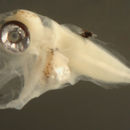Biology
provided by Arkive
The yellowfin tuna is a schooling fish, and has a strong tendency to aggregate with fish of the same size, rather that just school with other yellowfin tunas (2). They can often be seen swimming near the surface with other tunas, such as skipjack tuna (Katsuwonus pelamis)and bigeye tuna (Thunnus obesus). Large yellowfin tunas have also been seen with porpoises or dolphins, particularly the spotted, spinner and common dolphins (2) (4). Schools of yellowfin tuna under floating debris are also often observed (4).
This powerful swimmer is an opportunistic predator, feeding on a wide variety of fish, squid, cuttlefish, octopus, shrimp, lobster and oceanic crabs (2). Some of the fish consumed include pilchard, anchovy, mackerel, and even other tunas (2). They apparently locate their food simply by sight, as they search for food primarily in the surface waters during daylight (2).
Spawning in yellowfin tuna populations can occur at any time of the year, but is most frequent during the summer months in each hemisphere (4). Each female releases several million eggs each year into the ocean (2), which are fertilized by the sperm released by the males. Yellowfin tuna juveniles grow quickly, reaching a weight of 3.4 kilograms in 18 months (2).
Conservation
provided by Arkive
Like the other tuna species, yellowfin tuna fisheries are managed by international bodies: the International Commission for the Conservation of Atlantic Tunas (ICCAT) in the Atlantic (5), the Inter-American Tropical Tuna Commission (IATTC) in the eastern Pacific (6), and the Indian Ocean Tuna Commission (IOTC) in the Indian Ocean (7). The management measures in place have, for the large part, successfully maintained populations of the yellowfin tuna (8).
Description
provided by Arkive
The yellowfin tuna is a fish built for speed and endurance (3). Its streamlined body is metallic dark blue on the back, blending into yellow or silver on the belly. The belly is patterned with numerous broken lines (4), and a vivid golden stripe runs along each side of the body, from the eye to the tail (2). The yellowfin tuna has two dorsal fins, the second one of which can be very long and is situated directly over the long anal fin. The pectoral fins, those found on each side of the body, are also long, often reaching beyond the space between the two dorsal fins (4) (2). The fins can be retracted so that water flows even more smoothly over its body when swimming (3). Tiny fins, (or finlets), run down the top and bottom side of the body, from the second dorsal fin and the anal fin to the tail. These finlets, along with the dorsal and anal fins, are bright yellow, giving this fish its common name (4). The finlets are bordered by a narrow black band (4).
Habitat
provided by Arkive
The yellowfin tuna inhabits the epipelagic zone of the ocean, at temperatures between 18 and 31 degrees Celsius (4). It generally occurs at depths less than 100 metres (2).
Range
provided by Arkive
The yellowfin tuna is found worldwide, in tropical and subtropical waters from latitudes of 40°N to 35°S, although it does not occur in the Mediterranean Sea (2) (4).
Status
provided by Arkive
Classified as Lower Risk / Least Concern (LR/lc) on the IUCN Red List 2007 (1).
Threats
provided by Arkive
The yellowfin tuna is a popular and important target for commercial fisheries (2) (4). Around 35 countries have fisheries for this tuna species, with Japan and the USA bringing in the largest catches (4). While the IUCN classifies the yellowfin tuna as not currently threatened (1), a reduction in catches per unit effort in certain areas suggests that some yellowfin stocks may be decreasing (4).

